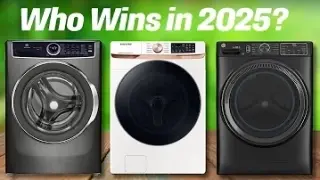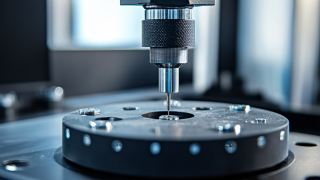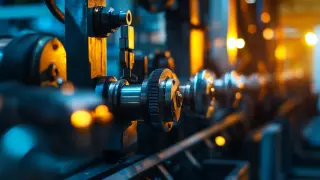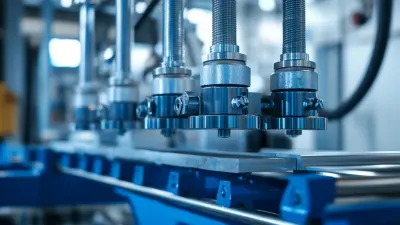 info@loadcellsensor.com
info@loadcellsensor.com 
-
Home
-
Products
-
News
-
About Us
-
Contact Us
Leave Your Message
-
 CONTACT LCS TECH
CONTACT LCS TECH -
 CONTACT LCS TECH
CONTACT LCS TECH



Despite all advancements in global industries, no one understands the importance of precision measurement technologies more than today. Washer Load Cell technology will transform every application involving weight and force measurements, beginning with the vision for 2025. It is pulling forward the needs for accuracy and reliability, firstly for its application in more demanding commercial and industrial environments but also for the increasing need for energy efficiency and sustainable solutions.
For us at LCS Tech Co. Ltd, we are here leading this new transformation, using our advanced strain gauge technology to provide high-quality load cells, force sensors, and torque transducers. Founded in 2012, our top quality and innovation reputation now, in an entirely proud way, puts the heft of "Made in China" behind our name. In their operations, Washer Load Cell technology will guide global buyers and lead them into smarter and more efficient solutions at 2025.

A very interesting development in washer load cell technology is that, as predicted, in 2025 greater efficiency and sustainability will emerge as very important factors. Industry reports corroborate that the worldwide load cell market is expected to reach $4.3 billion by 2025, growing at a compound annual growth rate (CAGR) of 5.1%. Amplification of demand for precision in industrial applications, together with increasing automation in manufacturing, serves as a catalyst in this case. Innovative sensor technology is undoubtedly one of the trends reshaping the washer load cell market. These smart load cells-with-Internet-of-Things (IoT) capability-are acquiring traction for real-time data monitoring and predictive maintenance, thus increasing process efficiency yet greatly reducing downtime. It is estimated based on MarketsandMarkets' report that the IoT in load cell technology may reduce operational expenses by about 20-30% in a few coming years. Moreover, sustainability directly influences the design of eco-friendly load cells. Manufacturers are investigating recyclable materials and energy-efficient production. According to Grand View Research, adopting sustainable practices in load cell manufacturing will increasingly influence purchasing decisions, with approximately 75% of consumers claiming preference for products bearing sustainable technology by 2025. These innovations not only fulfill global sustainability standards but also cater to the new lifestyles of environmentally aware consumers.
Innovations in washer load cell technology would redefine operational efficiencies and user experiences for the washing machine industry in the coming years. According to a recent report published by Market Research Future, the washing machine industry will be worth USD 80 billion by 2025. Therefore, the industry has to adopt smarter and more efficient technologies well in advance of this boom.
One of the main advancements in load cell technology is the inclusion of AI and IoT capabilities. AI-based load cells would calibrate detergent usage and water usage after analyzing load weight in real seconds. This feature not only makes the washing perfect, it also saves resources, creating interest among consumers who are environmentally conscientious. According to Statista, two-thirds-66%-of households wish for "green appliances more than anything" an indication that a market trend is in place towards this direction.
This facilitates very granular measurement of the load according to the varied types of fabrics and weight of loads. This ensures that the wash cycles are well matched to the load, resulting in minimized energy consumption on the one hand and prevention of fabric damage on the other. According to Allied Market Research, improving accuracy of sensors could lead to savings of as much as 25% in energy across the washing machine industry by 2025 and this would mean money in the pockets of the consumers and manufacturers as well.
Future of load cells in washing machines is highly dependent on smart homes. In fact, according to research carried out by Gartner, almost half of the households worldwide will adopt smart home technology in the next few years. Load cells will, therefore, also be able to communicate with other smart devices, which will allow users an easy experience for remote monitoring and control of washing machines, streamlining the experience. They are built to change the world as far as washing machines and other similar household appliances are concerned.
The smart technology integration in washer load cell systems is redefining the laundry appliance sector. Understanding the weight of laundry loads has always depended on the proficiency of load cells. More recently, it has been disclosed by industry reports that global smart washing machine sales alone are expected to increase by 20% a year as load cell technology and the smart features that accompany innovative designs are enhanced for improved load measurement that can drive energy saving and reduced water consumption.
This situation presents an opportunity. With smart technology, load cells are now equipped to transmit real-time data to the control system of the washer, thereby optimizing the washing cycle according to detected load size and soil level. In so doing, at one level the operation improves user convenience, and at another level it enhances the sustainability cause. An instance is smart washers with advanced load cells said to reduce water usage by as much as 30%, thus benefiting homeowners with substantial savings in costs while reducing wastage.
Further, with the advancement in digital connectivity, consumers can remotely control their laundry from mobile applications. This not only boosts increased user interaction but also ensures users get notified whenever the laundry is done, thus improving the overall experience of doing laundry. We can be sure that, in making decisions as to which washers to invest in, performance of the advanced load cells will be fiercely considered by global buyers, thus pushing wider the frontiers of innovation in the appliance industry.
The innovations in washer load cell technology appear in increasing alignment with the interests of sustainability as we draw closer to 2025. This growing demand for an environmentally friendly manufacturing process has sent designers and engineers back to reconsider the classical load cell constructions. By including sustainable materials and energy-efficient design principles, the industry reduces environmental impacts and enhances reliability of performance. These changes constitute an important trend creating a greener future for load cell technology.
Another important aspect of this evolution is the improvement of temperature compensation methods within the load cells. Precise measurement requires processing the temperature fluctuations considerably affecting the reading accuracy by the manufacturer. Improvement methods propose an innovative distribution of compensation resistors to reduce errors due to temperature variations. These improvements not only enhance operational efficiencies of load cells but also improve sustainability measures of the entire process.
On the other side, high-performance solutions are now developed to meet diverse industrial requirements. Next-generation technologies not only enhance performance in extreme conditions but also ensure lower carbon footprints. Caught in the midst of this transformation, washer load cell technology development will soon emerge into the spotlight, influencing the sustainable industrial frontier as global buyers become increasingly aware of their options of procurement. With such focus on innovations that balance product efficiency with ecological concerns, the industry is paving the way to a sustainable future.
The evolution of load cell technology used in washing machines has traditionally about two camps: the old and advanced systems. The bearing for most laundry appliances has been a common feature in traditional load cells, which use strain gauge sensors. Mechanical deformation produces a measure of weight using these sensors; essential functions include load balancing and adjusting the level of water in agitating devices. However, the systems are very sensitive to temperature and environmental changes which could affect accuracy as well as reliability over time.
On the contrary, advanced load cell technology is paving the way for performance and user interface enhancement. Modern designs have been featured with capacitive and piezoelectric sensing technologies, which improve true measuring ranges considerably and resist pretty high levels of aggressiveness factors such as temperature change. Such developments lead to optimal wash cycles, reduced water and energy consumption, and increase the overall availability of appliances. Furthermore, advanced load cell systems can also work exceptionally well with smart technology, giving room to more cost-effective performing washing machines monitored off-site, receiving real-time updates on wash cycles from the user's mobile device.
In terms of cost and complexity, traditional load cells are still cheaper, comforting companies that want to manufacture a product with a low price. However, the long-lasting benefits of advanced load cells in terms of energy efficiency and convenience characteristics are becoming very appealing to global buyers. As time goes on, with advancing technology, different consumers will always choose either depending on their priorities-more cost or more advanced.
The increased application of high-precision washing solutions is propelled around the world by technological development along with changing consumer preferences. Consequently, it is projected that the market for advanced washing appliances will grow at a CAGR of 9% over the next five years as of 2023, mirroring the general transition toward laundry technology that is taking the direction of more efficient and intelligent solutions. It's innovations such as washer load cell technology, which are typically heading this evolution, creating the greatest accuracy in achieving weight measurement and operational efficiency.
Emerging trends show that edge AI technology will be entering home appliances. The edge AI chip market will have a value greater than that of cloud AI chips by 2025. Not just processing power but also real-time analysis will be available on the appliances. In this way, machines with load cells would know how much water and detergent they would need in a given situation and waste less in overall performance.
Most significantly, the recent developments at CES 2025, such as super advanced robotics solutions, testify the commitment of the industry to innovation. What with companies such as Suoteng developing and displaying their self-made humanoid robots among other products, it is evident that rooting automation and smart technologies in household appliances is probably becoming an essential norm. The new normal is configured to capitalize on the continually rising demand for precision in this segment, while also paving the road for new opportunities in the global marketplace as the benchmark for washing solutions in future.
Heavy development in the washer load cell technology is continuing, more than ever so, due to an increase in the need for accuracy and reliability in weighing systems. The global market pushing for smarter, efficient solutions is throwing challenges at manufacturers, who have to see the integration of new materials and circumnavigate limitations in data processing. Various reports point that the global load cell market was estimated to attain USD 1.98 billion by 2025, highlighting the competitive urgency for innovation in this field.
For the development of next-generation load cells overcoming certain roadblocks needs to be done, such as miniaturization of the sensors, calibration repeatability, and adoption of IoT technologies for real-time data transfer. Researchers are looking into solutions, whereby artificial intelligence can be applied so as to render greater diagnostic and predictive maintenance capabilities to the load cells. AI could drastically improve the functioning of weighing systems by quickly recognizing anomalous conditions that traditional sensor technology would often miss, thereby enhancing operational efficiency.
Apart from that, industry collaboration is key to resolving such issues. Innovations like the recent innovation forums and conferences serve to encourage joint initiatives amongst technologists, manufacturers, and academics to devise comprehensive strategies for future advances. By aligning the interests of different stakeholders, washer load cell technology can be made to evolve in meeting the demands of global buyers while assuring reliability and precision in different applications.
The technological revolution to be adopted in washer load cell is foreseen in 2025, which will impact worldwide buyers. The emerging focus on precision and efficiency makes it possible for load cells to be designed more organically to link with the advanced manufacturing process automation systems. Thus, the benefits become twofold: improved operational efficiency coupled with a better experience for the end-client.
Washers have to know it all when it comes to emerging developments in load cell technological advancement because there is increased endurance and sensitivity in all these gadgets. New forms use new materials in their constructions as well as brains to boost productivity in a very aggressive scenario. While buyers will know about these advancements, they will be in a position to get washers that will serve their present and future operational needs.
Moreover, towards the smarter thing, it also goes in favor of buyers considering systems that will provide connectivity and integration to the Internet of Things (IoT). This facilitates real-time monitoring and/or data analysis to increase productivity and better quality of decision-making. Yet, staying updated on these innovations is paramount for making investments in future-proof washer technology.
The global market for load cells is projected to reach $4.3 billion by 2025.
The load cell market is expected to grow at a compound annual growth rate (CAGR) of 5.1%.
Smart load cells with IoT capabilities enable real-time data monitoring and predictive maintenance, enhancing operational efficiency and reducing downtime.
The implementation of IoT in load cell technology could decrease operational costs by approximately 20-30% over the next few years.
Manufacturers are exploring the use of recyclable materials and energy-efficient production methods to create eco-friendly load cells.
Approximately 75% of consumers indicate a preference for products made with sustainable technologies by 2025.
Manufacturers face challenges such as sensor miniaturization, calibration consistency, and the integration of IoT technologies for real-time data transmission.
AI can enhance the accuracy of weighing systems by quickly identifying anomalies that traditional sensors may overlook, improving overall operational efficiency.
Industry collaborations foster partnerships among technologists, manufacturers, and academics to create comprehensive strategies for future advancements in load cell technology.
The global load cell market is projected to reach USD 1.98 billion by 2025, emphasizing the competitive pressure for innovation in this sector.




